|
To accompany the UK
release an iconic
quad-crown poster designed by
Eric Pulford and
illustrated by
Renato Fratini went through several iterations before its final
rendition of Sean Connery as James Bond 007, surrounded by provocative
images of women and a small vignette emphasising the exotic nature of the
film, was approved. The main image of Sean Connery with a sardonic smile
and holding a pistol across his chest became THE iconic image of the
character that has appeared in some form or other on Bond posters ever
since. However, the use of an air pistol instead of 007’s signature
Walther PPK came about purely by accident. Celebrated photojournalist
David Hurn (1934- ) was hired by Publicist
Tom Carlile to take a series of
publicity photographs of Sean Connery, Daniela Bianchi, and the other
actresses in the film for use during the promotion of From Russia With
Love. Unfortunately, Carlile forgot to bring the Walther PPK to the
session, and Hurn being a keen amateur marksman offered his own Walther
LP53 .177 air pistol for the photoshoot. Assured that the incongruous
weapon could be airbrushed or altered by retouching in any posters that
were based on the publicity stills, the photoshoot went ahead with the air
pistol, which resulted in probably the most iconic series of stills ever
taken for the James Bond film series. Unfortunately, nobody briefed the UK
poster designers and the long-barrelled weapon featured as the centrepiece
of the British advertising campaign, although some early concept designs
do show the Walther PPK. Hurn’s Walther air pistol was originally sold in
auction at CHRISTIE'S in 2001 for £14,100;
and again for a world record $437,000 (£277,250) in 2010, and
most recently in 2013 in the USA for
$300,000. Unlike Dr. No (1962), which featured more of less the
same advertising campaign on posters on both sides of the Atlantic, for
the second James Bond film, alternate retouched versions of David Hurn’s
stills were used by United Artists graphic designer
David Chasman
throughout the American campaign. |
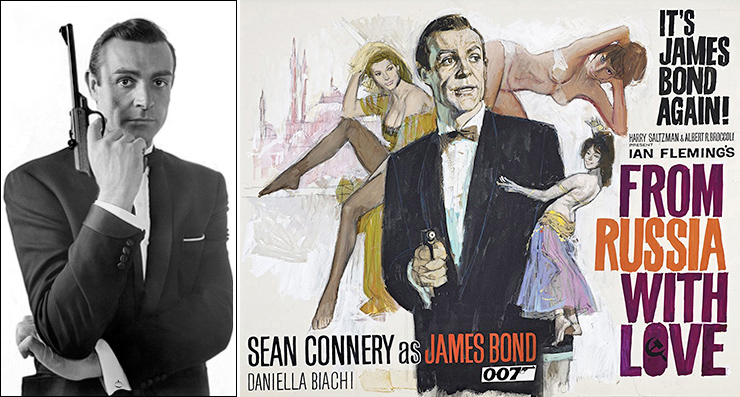 |
|
ABOVE: (left) One of
the iconic publicity stills taken by photographer David Hurn,
showing Sean Connery holding a Walther LP53 air pistol instead of
his trademark PPK. (right) A poster concept by Renato Fratini
showing Sean Connery this time with the Walther PPK. The concept
shows the genesis of the final poster, although the bikinied
figure was dropped and replaced by the gypsy fighting girls. At
this stage the tag-line was “It's James Bond Again!”, which
ultimately became the more familiar “James Bond Is Back!” on the
final version. It is also interesting to note the use of the 007
gun logo which ultimately didn’t appear in any UK advertising
until 1969 for the film OHMSS. The final poster and most
promotional material for From Russia With Love (1963)
retained the logo originated by PAN Books, with a pistol and two
bullets, which was also used on the Dr. No (1962)
quad-crown poster. UK advertising introduced the hammer-and-sickle
device inside the ‘O’ of ‘LOVE’; whereas the US logo actually used
the device in place of the letter ‘O’. (Note also the mis-spelling
of Daniela Bianchi's name on the concept poster.) |
|
|
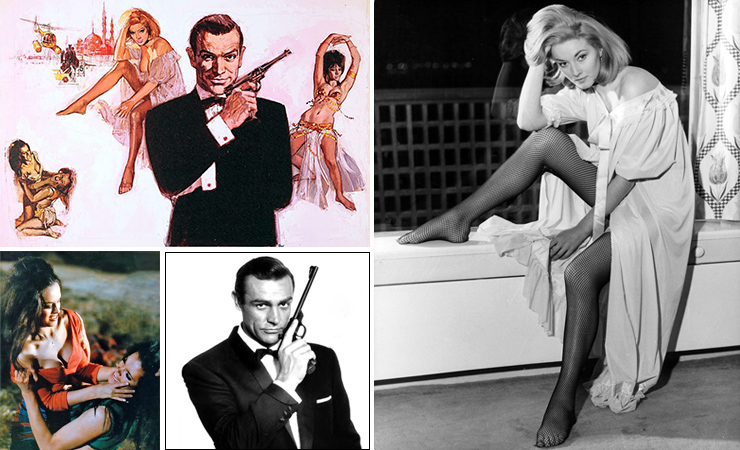 |
|
ABOVE: (top left)
Renato Fratini's original artwork (based on a design by Eric
Pulford), although the face of Sean Connery was later slightly
altered in the final rendering to show the more cruel sardonic
smile of 007 [pictured below]. The final poster was based on a
number of publicity stills including those of Connery holding the
Walther LP53 air pistol that was intended to be retouched to
resemble the PPK, but only carried out on the US posters. (right)
The publicity still of Daniela Bianchi used as reference on the UK
quad-crown poster, and (bottom left) the reference still of
Martine Beswick and Aliza Gur as gypsy fighting girls Zora and
Vida. (bottom centre) Another of the shots of Sean Connery from
the original David Hurn photo session. The iconic stills of Sean
Connery holding the Walther LP53 across his face or chest was used
throughout the From Russia With Love publicity campaign,
with the image of ‘Bond and Gun’ then appearing in some form or
other on posters for almost all subsequent films in the series.
BELOW: The final From Russia With Love UK quad-crown poster
designed by Eric Pulford and painted by Renato Fratini. |
|
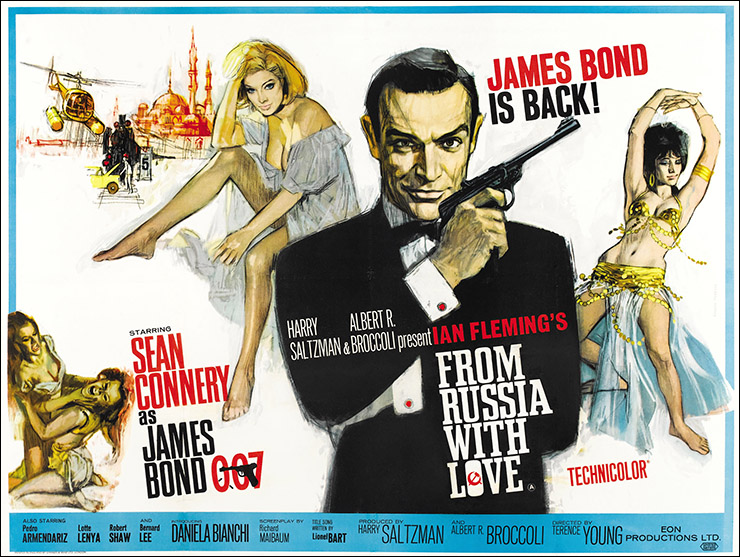 |
|
|
The final stages of
post-production began on September 16, 1963 – where the sound, editing and
music dubbing were finalised. The completed film was then sent to the
Technicolor labs who delivered 75 release prints on October 7th – just one
day before the press screening held at the ODEON Leicester Square. The
final cut of the film had been trimmed slightly by the British Board of
Film Censors in order to achieve its ‘A’ certificate. Although the Board
was beginning to relax its views on sex and violence in British cinema,
From Russia With Love clearly went beyond the bounds of a mainstream
commercial film intended for a general audience at that time. Board
Secretary John Trevelyan (1903-1986) ordered several cuts to From
Russia With Love to tone down the sexual content of the film; a
handful of suggestive lines between Bond and Tania were cut, in addition
to several shots of the gypsy belly dancer Leila Guirat, and the
subsequent fight between Martine Beswick and Aliza Gur. Treveleyan also
ordered the removal of a shot of Tania walking naked towards Bond’s bed
just before their first meeting (actually a double wearing a flesh colour
body-stocking). This shot was the only one restored to the film when
reclassified by the BBFC for home video release in 1984. The Board also
suggested shortening and darkening the sequence where Bond and Tania are secretly filmed
in the bridal suite of their Istanbul hotel. One more harmful trim was Grant’s line, “What a
performance!” when he comments on the secretly shot reel of film as he
taunts Bond on board the Orient Express. At the end of the film in the
print submitted to the censor, Bond repeats the line as he looks at the
film reel before tossing it into the Venetian canal. The censor’s edit
here results in a clumsy jump cut which has been present in all versions
of the film since 1963. The trims were noted in a memo sent to United
Artists executive Robert Blumofe in January 1964 by the US censor Geoffrey
Shurlock. The export prints of From Russia With Love were then
conformed to the UK original release. The cut material is presumed lost.
Unlike BBFC trims made to later films in the series, these cuts have never
been restored. Ironically, Robert Blumofe was one of the UA executives who
originally vetoed Sean Connery’s casting as James Bond in 1961! |
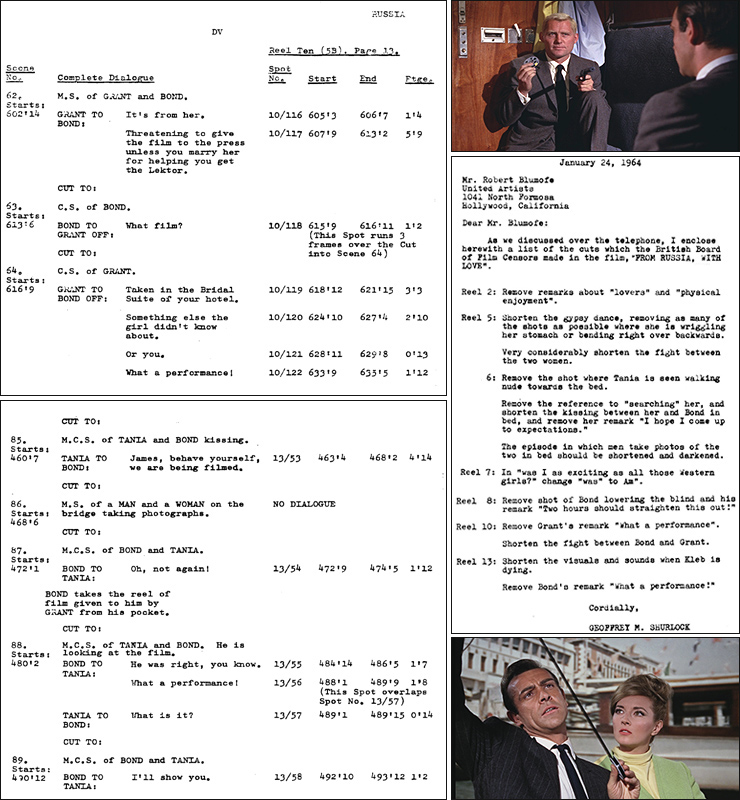 |
|
ABOVE: (top left) An
original
From Russia With Love (1963) cutting continuity document
showing Grant's line of dialogue “What a performance!” as it originally
appeared in the shooting script. (bottom left) The same line is
later repeated by James Bond, and both instances were deleted from the
release prints of the film by the British Board of Film Censors.
(centre right) A memo from US censor Geoffrey Shurlock to United
Artists executive Robert Blumofe, detailing the cuts made to
From Russia With Love by the BBFC, which were also made to the
International version of the film released in US cinemas in April
1964. |
|
|
|
From Russia With Love
then opened at the ODEON Leicester
Square in London on Thursday October 10, 1963 – with the first public
screening at 12.40pm. The final performance of the day beginning at 8.20pm
was designated as a ‘Gala Screening’ with many cast and crew members
present, including director Terence Young and co-producers Harry Saltzman
& Albert R. Broccoli. Sean Connery attended with his parents and wife,
actress Diane Cilento. Co-stars Robert Shaw [with his wife, actress Mary
Ure] and Daniela Bianchi were also invited to the Gala Screening and after
party. James Bond author Ian Fleming also attended the screening and
afterwards hosted his own private party for friends at his London home in
Victoria Square. A week later Ian Fleming wrote to his friend Amherst
Villiers in the USA telling him, “… the first night of ‘From Russia With
Love’ was a majestic success and the queues formed all day round and round
Leicester Square where it is showing at the Odeon.“ It was just the boost
Fleming needed, as in another six weeks he would find himself under a
different spotlight in the High Court in London, as
Kevin McClory’s
THUNDERBALL plagiarism case finally came to trial. Embarrassed and
defeated, Ian Fleming eventually settled the case out of court with
McClory winning the screen rights to the 1961 James Bond novel. |
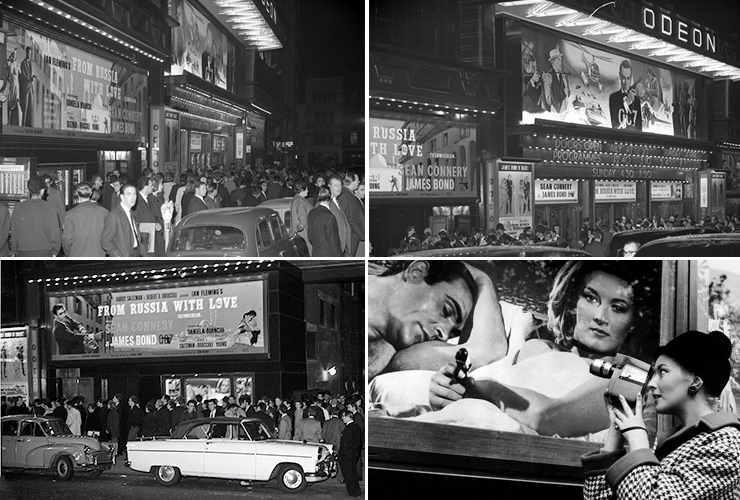 |
|
ABOVE: The ODEON
Leicester Square on the evening of Thursday October 10, 1963.
From Russia With Love had a ‘Gala Screening’ at 8.20pm with
many cast and crew members attending the fourth performance of the
day. Daniela Bianchi returned the next day (bottom right) with her
8mm cine camera to capture footage of the ODEON exterior marquee
which featured huge stills of herself and Sean Connery, in
addition to the unique artwork on display above and either side of
the entrance to the cinema.
BELOW: (left) A special quad-crown poster was printed for the
ODEON Leicester Square engagement of From Russia With Love
(1963), but was also displayed at a handful of other screenings
including (right) the New Victoria cinema [renamed ODEON Clerk
Street in 1964] in Edinburgh which was attended by Sean Connery's parents
Joseph and Euphemia. |
|
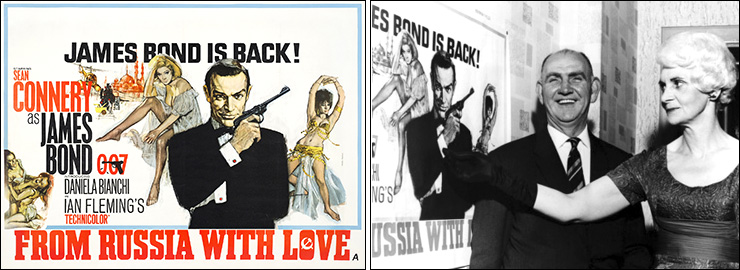 |
|
|
From Russia With Love
opened in larger towns and cities across the UK on Sunday, October 13,
1963, and proved incredibly popular, with many cinemas holding the film
over for a second or third week. Due to its enormous success From
Russia With Love was also shown for three weeks at the 2,400-seat
ODEON Marble Arch from Thursday October 17, 1963, and became the first
film ever to play simultaneously in four West End cinemas. It is no
surprise that From Russia With Love subsequently became the
highest-grossing British film of all time on its initial release, and
broke the house record at the ODEON Leicester Square, taking £14,528 in
its first week. The success of From Russia With Love prompted a
re-release of Dr. No (1962) in many cinemas across the UK toward
the end of 1963. Director of photography on both films
Ted Moore went on
to win the award for Best Cinematography (Colour) for his work on From Russia With
Love at the 1964 BAFTA ceremony. |
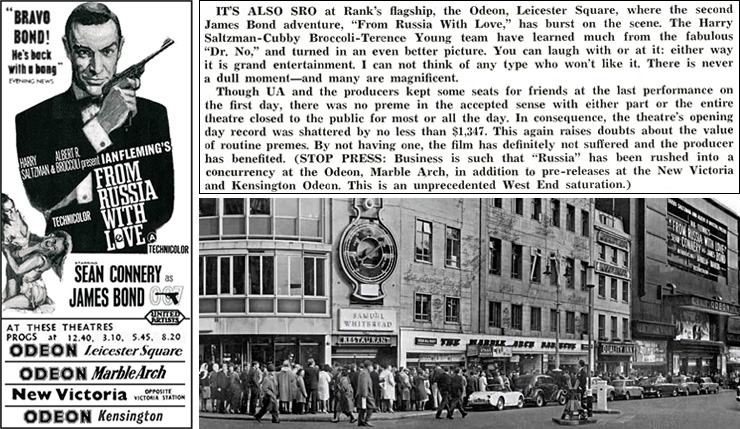 |
|
ABOVE: STANDING ROOM ONLY! (left) From Russia With Love opened to rave
reviews at the ODEON Leicester Square, and a week later was
playing concurrently in four West End cinemas. (top right) The US
Trade journal Motion Picture Exhibitor reported in their
October 23, 1963 edition that the second James Bond film had
opened at the ODEON Leicester Square without a premiere in the
accepted sense of the word. The four sell-out performances consequently shattered the
opening day record at the cinema.
(bottom right) The queues around the block in Leicester Square as
From Russia With Love continued to break records, going on
to then become the most successful British film of all time on its
original release. This was a
full six-months before From Russia With Love would open in the USA
on April 8, 1964.
BELOW: (left) A unique poster hoarding advertising the
opening of From Russia With Love at the ODEON Glasgow on Monday October 14, 1963. The
poster also advertises the supporting feature that was ultimately
never shown. In order to capitalise on the enormous public
demand to see the From Russia With Love, the original
85-minute supporting feature Stowaway In The Sky (1960) was
replaced by a 24-minute documentary/travelogue This is Jordan
(1963), which enabled cinemas to schedule more screenings each
day. To the right of the ODEON poster, the billboard advertises
The Princess Pocahontas which opened at the Alhambra Theatre
on the same day. The stage musical featured Terence Cooper, who in
1967 would play ‘James Bond 007’ in Casino Royale. (centre) A full-page advertisement in the January 8, 1964
edition of Variety alerts audiences to the record-breaking
success of the second James Bond film ahead of its US opening
three months later. (right) From Russia With Love is
promoted in a more low-tech manner when the film plays at the
ODEON in the Leicestershire market town of Loughborough! |
|
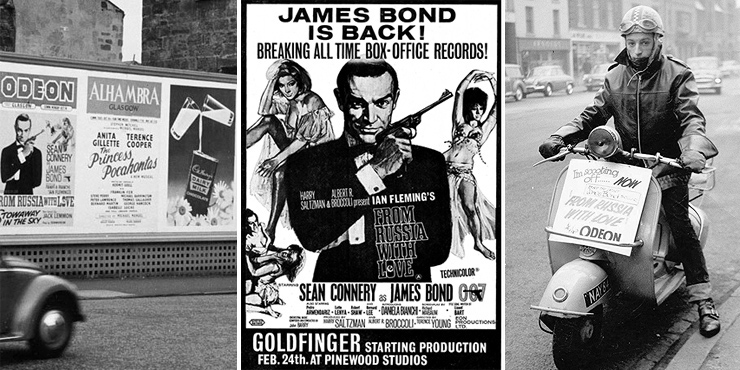 |
|
|
CONTINUED >> |

|
|
|
|
|
